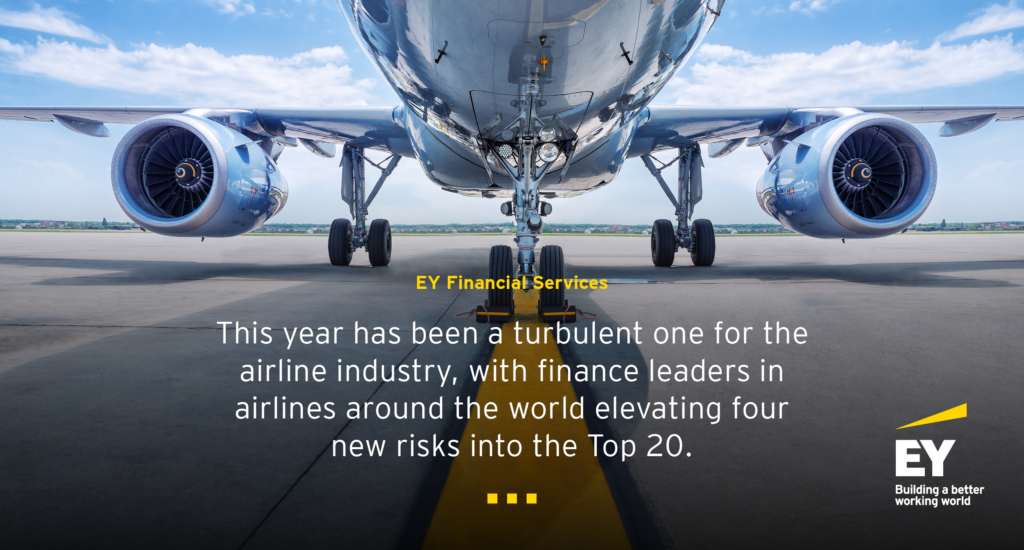Following the grounding of the Boeing 737 MAXs, airline executives participating in EY’s 2019 survey of the Top 20 risks facing global airlines have rated brand reputation as the 7th biggest risk they face and a major accident as the 11th. Neither of these featured in last year’s Top 20 list, writes Seamus Feeney, Senior Manager, Banking & Capital Markets at EY Financial Services, for the December issue of Aviation Finance.
This year has been a turbulent one for the airline industry, with finance leaders in airlines around the world who participated in the annual EY survey elevating four new risks into the list of the Top 20 risks facing global airlines. The most notable new entrants were ‘Brand Reputation’ at number 7 and ‘Major Accident’ at 11. These risks can be linked to recent aviation accidents and the associated impact on the brands of the airlines involved and the manufacturer itself. The heightened awareness of the potential impact of accidents on airlines is likely to remain, given the level of public concern following the grounding of the Boeing 737 MAX aircraft.
For the fourth year in a row ‘Competition’ was identified as the number one risk facing global airlines. The recently published 2019 EY survey included responses from airline executives in both the Americas (North and South), Europe, the Middle East, India and Africa (EMEIA) and Asia Pacific and Japan (APAC).

As in 2018, ‘Fuel prices’ were identified as the number two risk facing global airlines (read the 2018 survey results here). This emphasises the impact of fluctuations in oil prices on the global aviation industry and their corresponding impact on the profits of airlines.
The other two new entrants in the list of Top 20 risks were ‘Technological Innovations, (in 18th place) and ‘Access to Capital and Liquidity’ (20th). The introduction of technological innovations relates to the increased focus from the global aviation industry on new technology to address climate change and drive operational costs lower. There has been a significant global focus during 2019 on climate change and the related impact of air travel on the same.
With the arrival of the four new entrants, four risks have dropped out of the to the Top 20. These are ‘Replacement of aging aircraft, ‘Terrorism, ‘Customer-facing innovation’ and ‘Industry consolidation/alliances’.
The most significant jump up the list is the ‘Foreign Exchange’ risk, which has moved up 3 places to 8th. The next two most significant moves up the list were for ‘Data Intelligence Threats and Cybercrime’, up 2 places to 3rd, and ‘Macroeconomic Factors’, up 2 places to 5th.
The most significant falls were for ‘Technology enablement,’ down 7 places to 13th, and ‘Strategic Initiatives for Revenue Growth,’ down four places to 12th.
The Americas and APAC both rate ‘Competition’ as their number one risk, whereas airline executives in EMEIA, as last year, rate ‘Fuel Prices’ as their number one risk. Likewise, the number two risk varies across the regions, with ‘Cost Control’ featuring in the Americas, ‘Data Intelligence Threats and Cybercrime’ in EMEIA and ‘Key Labour Shortages’ in APAC. The number three risks were ‘Fuel Prices’ in the Americas, ‘Competition’ in EMEIA and ‘Strategic Initiatives for Revenue Growth’ in APAC.
‘Operational risks’ were the most prevalent in the Top 20 risks in 2019 at 34 percent (down two percentage points). ‘Strategic risks’ represented 33 percent (up one point) and financial risks represented 24 percent (up two points) and ‘Compliance risks’ decreased by one point to 9 percent.
| 2019 | Risk | 2018 |
| 1 | Competition | 1 |
| 2 | Fuel prices | 2 |
| 3 | Data intelligence threats and cybercrime | 5 |
| 4 | Cost control | 3 |
| 5 | Macroeconomic factors | 7 |
| 6 | Safety management | 4 |
| 7 | Brand reputation | N/A |
| 8 | Foreign exchange | 11 |
| 9 | Key labour shortages | 9 |
| 10 | Business interruption | 10 |
| 11 | Major accident | N/A |
| 12 | Strategic initiative for revenue growth | 8 |
| 13 | Technology enablement | 6 |
| 14 | Labour negotiations | 12 |
| 15 | Regulatory compliance risk | 13 |
| 16 | Contract and vendor management | 15 |
| 17 | Threat from low-cost carriers | 16 |
| 18 | Technological innovations | N/A |
| 19 | Geopolitical unrest | 20 |
| 20 | Access to capital and liquidity | N/A |